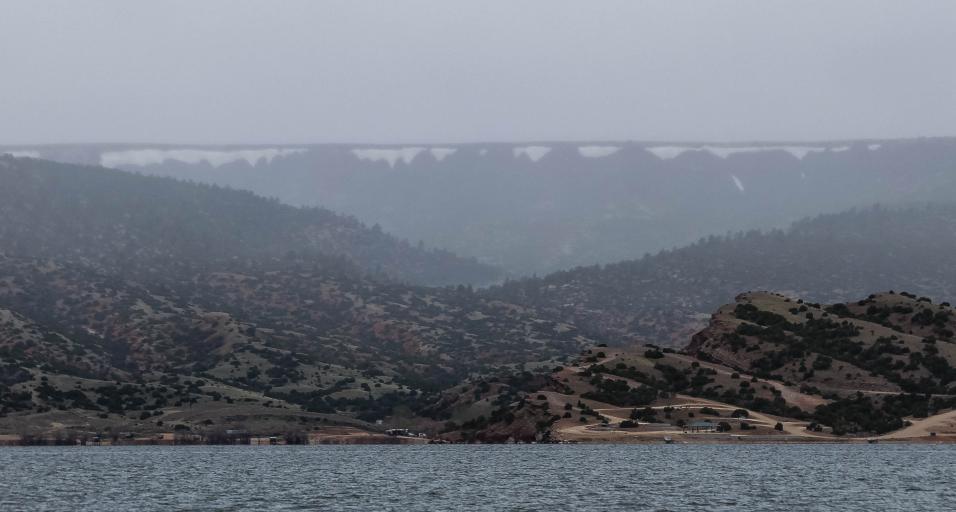Casper area reservoir surveys report good fishing and variety
The Casper Fish Management crew completed fall surveys on Alcova, Pathfinder and Seminoe Reservoirs. Fish managers shared what they learned about these popular fisheries about walleye, trout, and kokanee before the winter ices these waters over.
Game and Fish is seeing evidence of good recruitment at Pathfinder and Seminoe Reservoirs from two years ago, as well as large numbers of older, larger fish.
"This means walleye fishing should continue to be stellar on Pathfinder and Seminoe for the foreseeable future," Matt Hahn said, Casper regional fish supervisor.
Game and Fish is in the second year of a five-year project to evaluate trout stocking in Alcova Reservoir. In order to study whether rainbow trout are the best fit for the lake, Game and Fish started stocking kokanee, Bear River cutthroat and Snake River cutthroat in addition to rainbow trout. The study is designed to gauge survival, growth and angler catch rates of these species compared to rainbow trout.
"It is still early in the study, but the results after one year show Bear River cutthroat survived better than rainbow trout, while Snake River cutthroat survival did not differ from rainbow trout," Hahn said.
Gauging kokanee survival is more difficult because they are not easily sampled with traditional trout gill-net sets. However, kokanee did survive and are being caught by anglers. Game and Fish plans on conducting a sonar estimate of kokanee this summer (using a high-tech sonar unit to conduct a population estimate) which will help evaluate survival of kokanee relative to rainbow trout.
Game and Fish will continue to stock kokanee, Bear River cutthroat, Snake River cutthroat and rainbow trout for several more years at which point fish managers will collect and analyze data to make a determination on future trout management at this popular fishery.
Game and Fish is seeing evidence of good recruitment at Pathfinder and Seminoe Reservoirs from two years ago, as well as large numbers of older, larger fish.
"This means walleye fishing should continue to be stellar on Pathfinder and Seminoe for the foreseeable future," Matt Hahn said, Casper regional fish supervisor.
Game and Fish is in the second year of a five-year project to evaluate trout stocking in Alcova Reservoir. In order to study whether rainbow trout are the best fit for the lake, Game and Fish started stocking kokanee, Bear River cutthroat and Snake River cutthroat in addition to rainbow trout. The study is designed to gauge survival, growth and angler catch rates of these species compared to rainbow trout.
"It is still early in the study, but the results after one year show Bear River cutthroat survived better than rainbow trout, while Snake River cutthroat survival did not differ from rainbow trout," Hahn said.
Gauging kokanee survival is more difficult because they are not easily sampled with traditional trout gill-net sets. However, kokanee did survive and are being caught by anglers. Game and Fish plans on conducting a sonar estimate of kokanee this summer (using a high-tech sonar unit to conduct a population estimate) which will help evaluate survival of kokanee relative to rainbow trout.
Game and Fish will continue to stock kokanee, Bear River cutthroat, Snake River cutthroat and rainbow trout for several more years at which point fish managers will collect and analyze data to make a determination on future trout management at this popular fishery.
The walleye population is trending down in Alcova right now. The catch rate in the standard fall gill-net sampling fell from a high of 0.60 walleye per hour in 2012 to 0.26 walleye per hour in 2016.
"On the surface, it would appear the increased limit is responsible for the decline in walleye, but the data paints a different picture," Hahn said.
Hahn explained fish managers can measure annual survival rates of a population using gill-net catch data in conjunction with fish age data collected from the fish themselves.
"We are seeing the annual survival rate for wall-eye between two and six years old (13 to 22 inches) actually increased from around 40% before 2012 to 50% currently, meaning a larger percentage of the population is surviving over the course of the year. On top of this, we measure year class strength as the number of two-year-old walleye caught in our sample from year to year," Hahn said. One-year-old walleye are too small to catch reliably.
"On the surface, it would appear the increased limit is responsible for the decline in walleye, but the data paints a different picture," Hahn said.
Hahn explained fish managers can measure annual survival rates of a population using gill-net catch data in conjunction with fish age data collected from the fish themselves.
"We are seeing the annual survival rate for wall-eye between two and six years old (13 to 22 inches) actually increased from around 40% before 2012 to 50% currently, meaning a larger percentage of the population is surviving over the course of the year. On top of this, we measure year class strength as the number of two-year-old walleye caught in our sample from year to year," Hahn said. One-year-old walleye are too small to catch reliably.
This data shows Alcova walleye had good reproduction in 2009 and 2012, but had below average reproduction since. Because the survival rate has increased, this leaves poor reproduction as the likely cause for behind the decline in walleye numbers at Alcova.
---
Want more news about fishing in the Casper area? Visit the Casper Regional webpage and sign up for their news and updates.
Story by: Janet Milek, Public Information Specialist, Casper Region
Janet Milek (janet.milek@wyo.gov)

